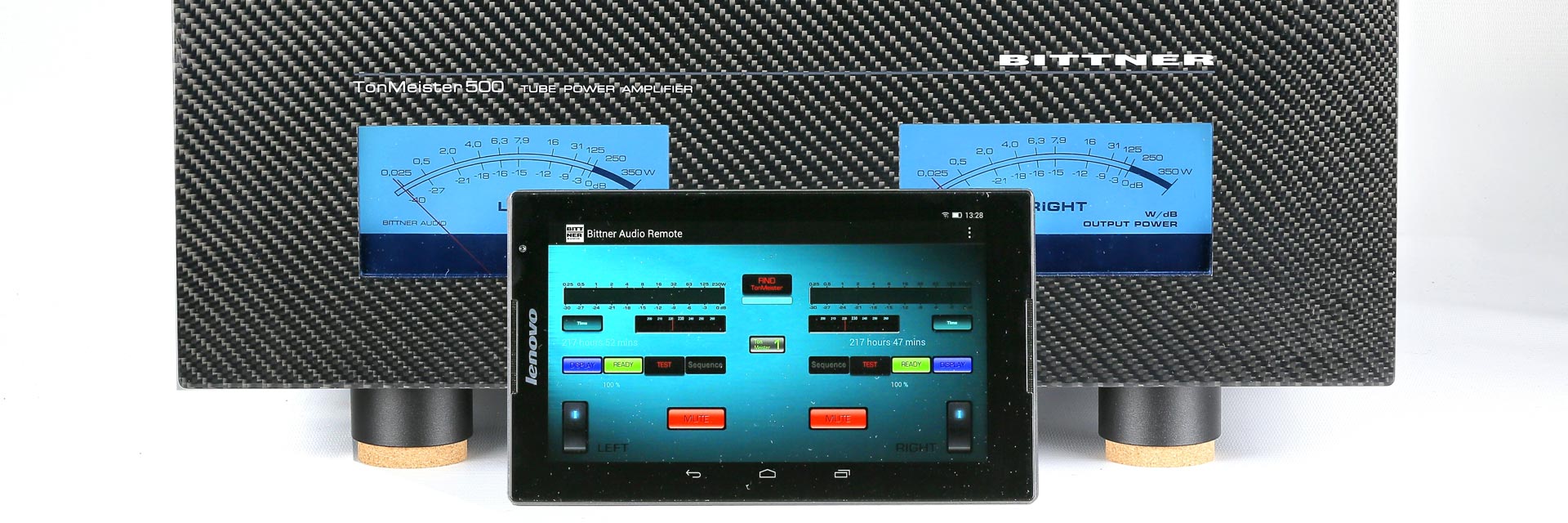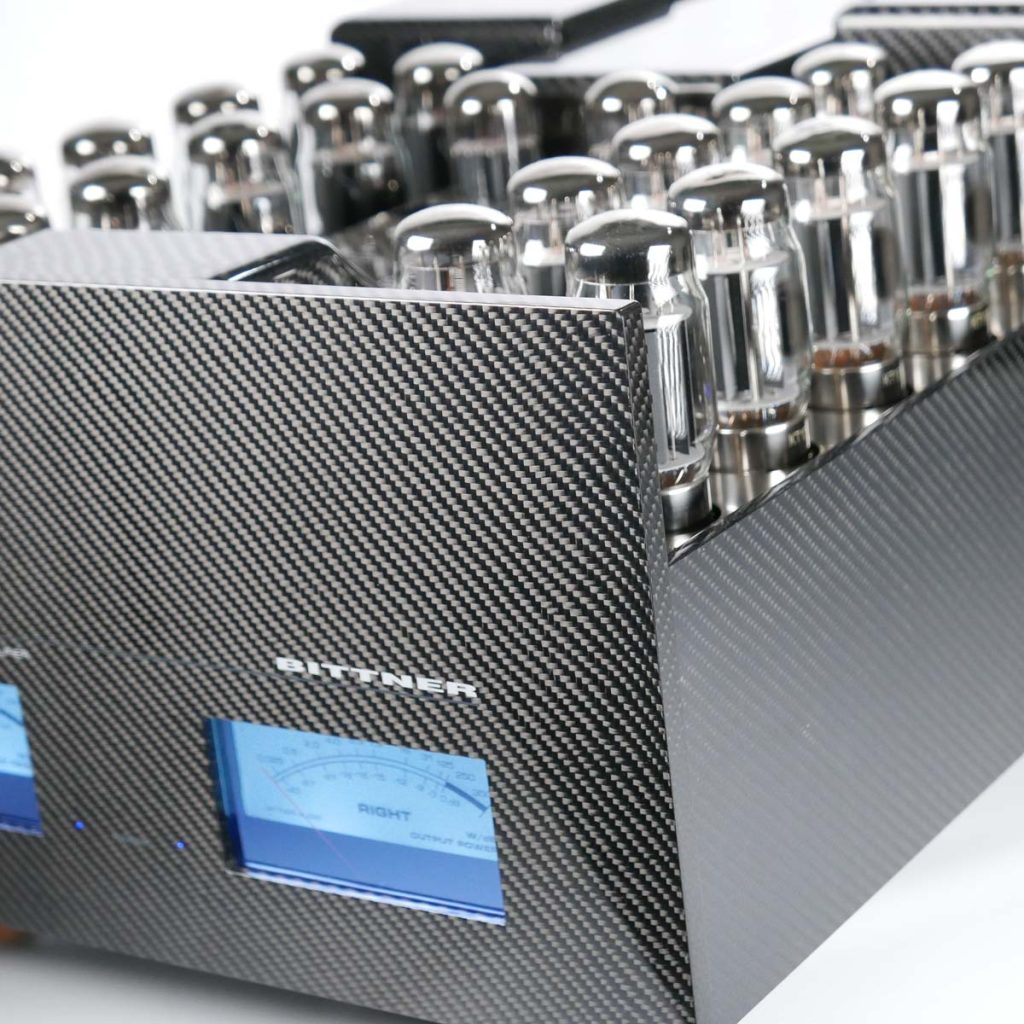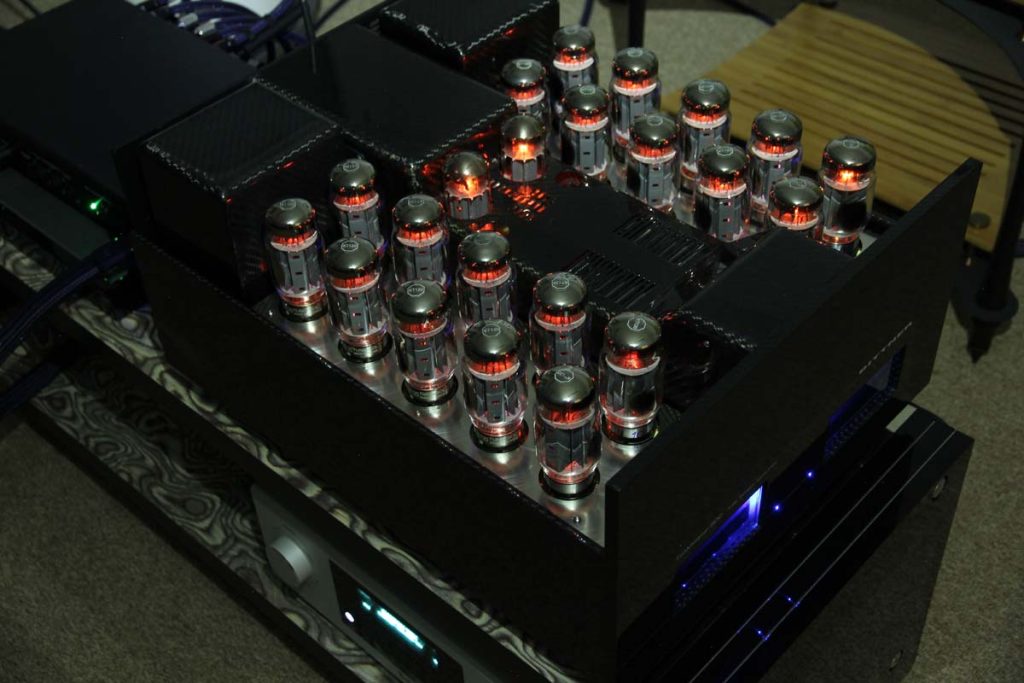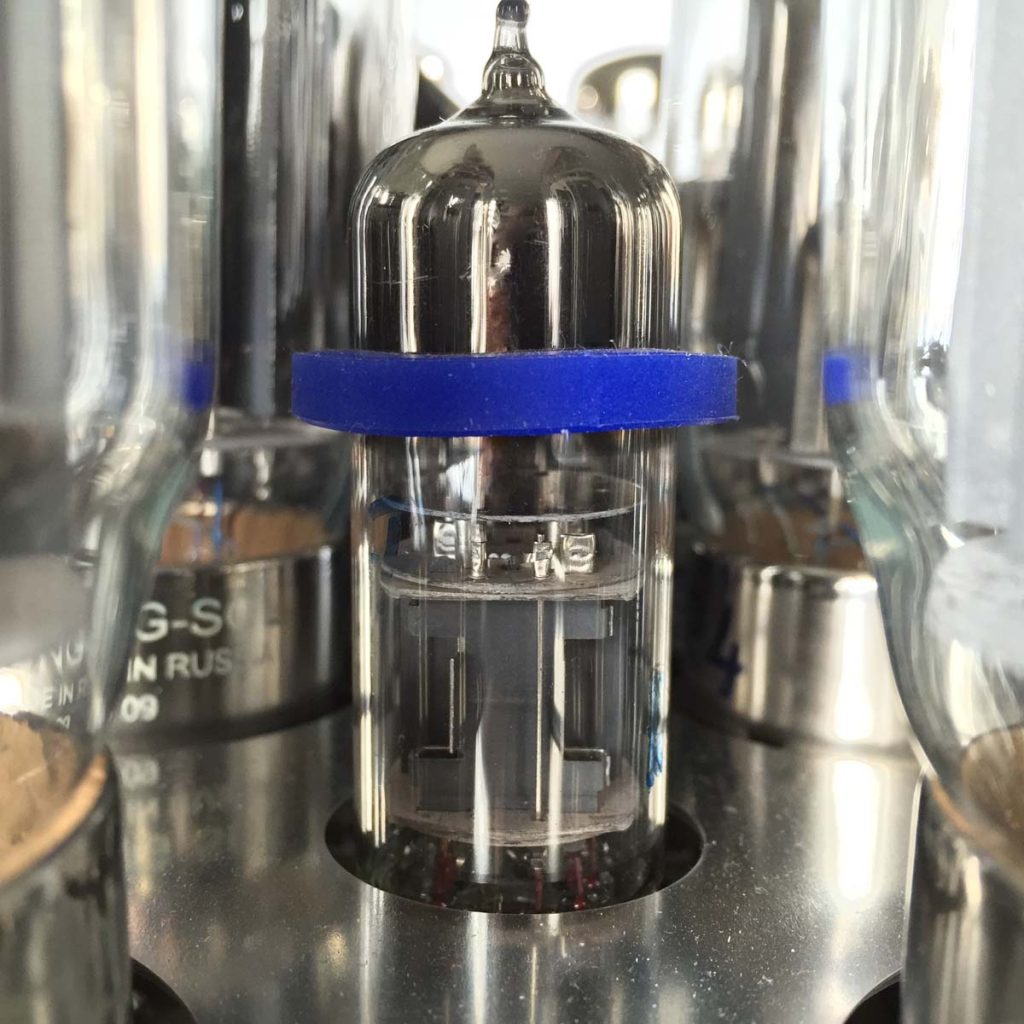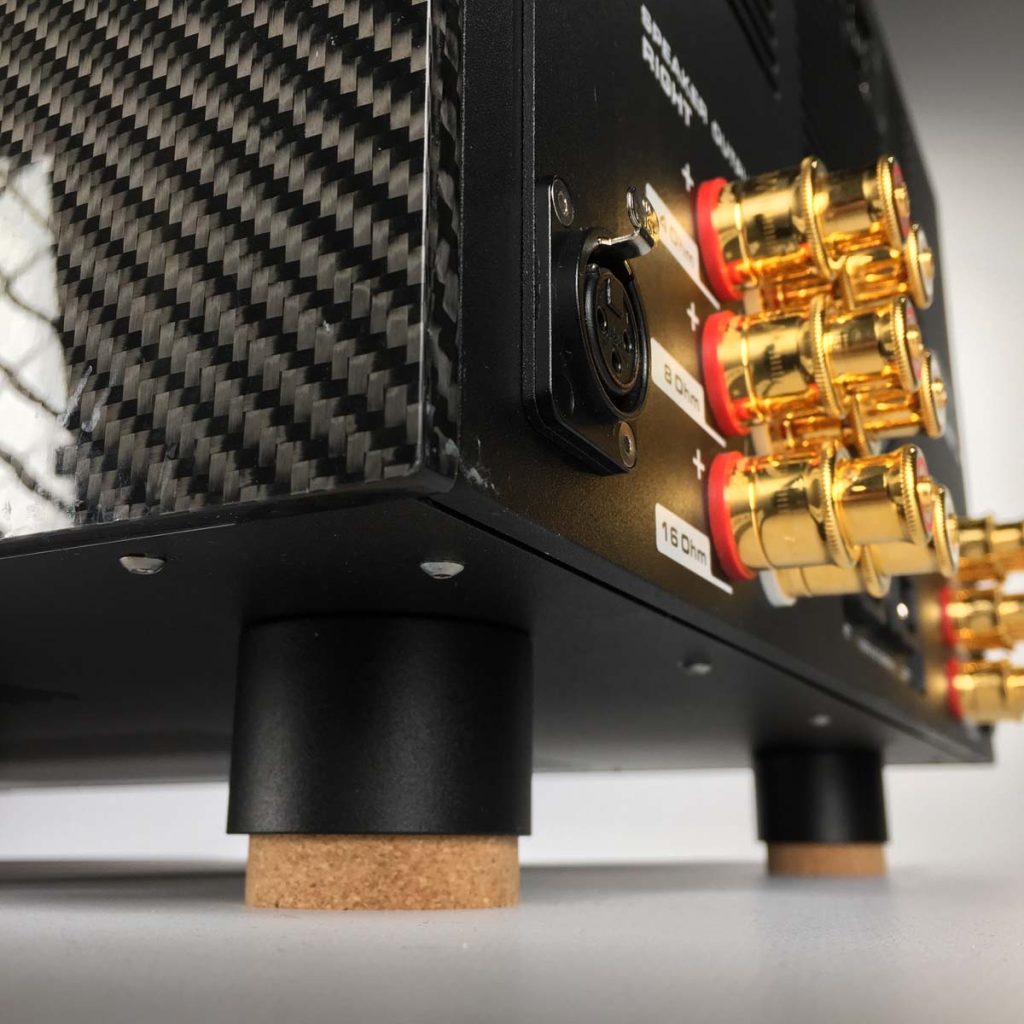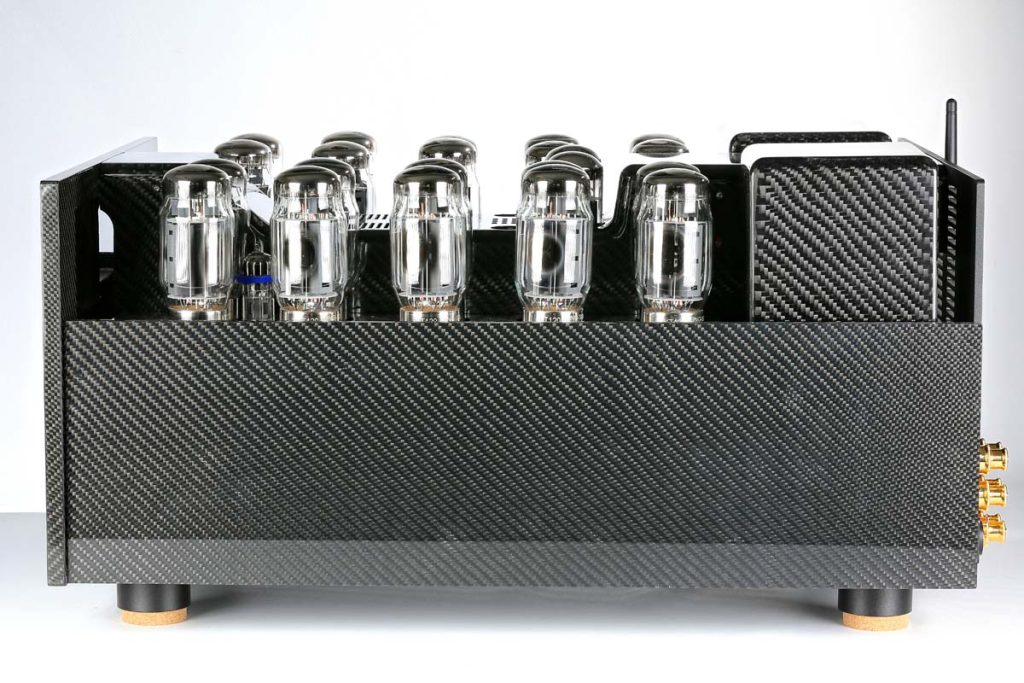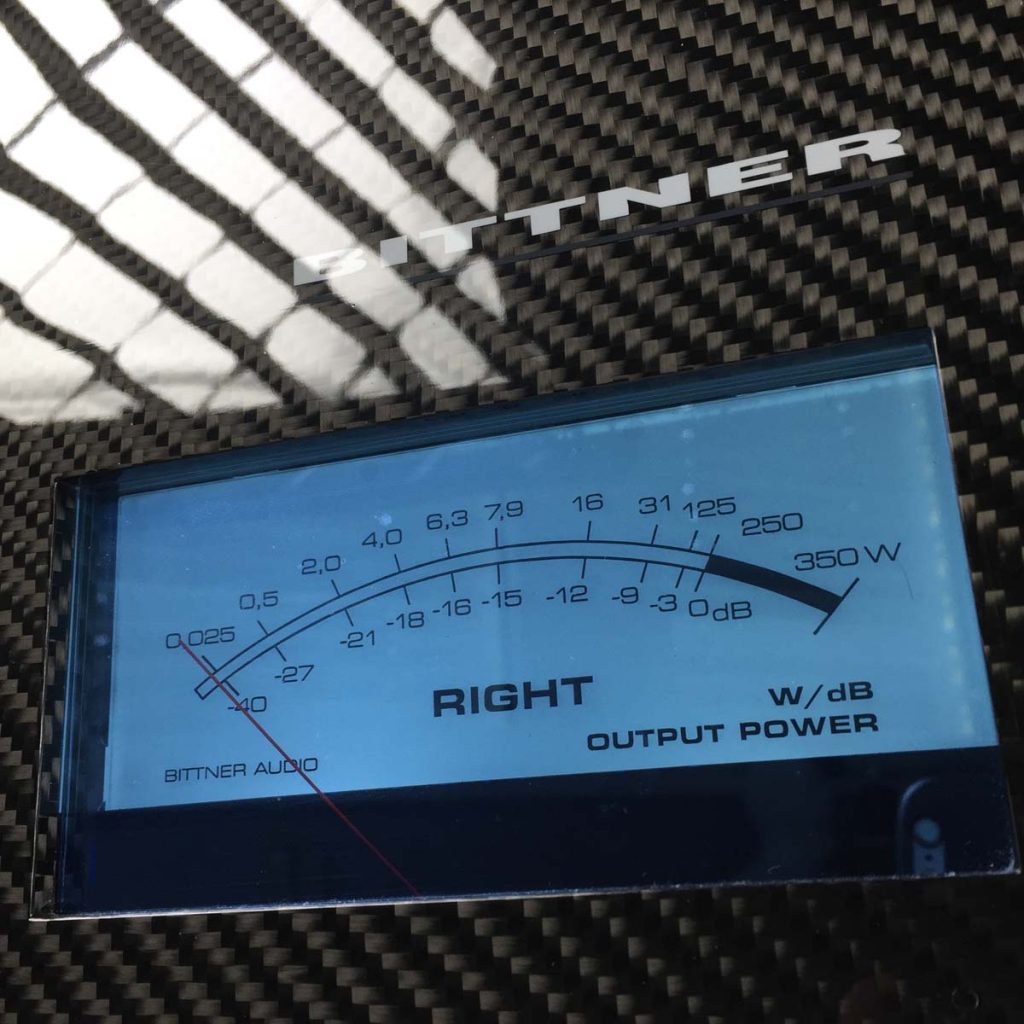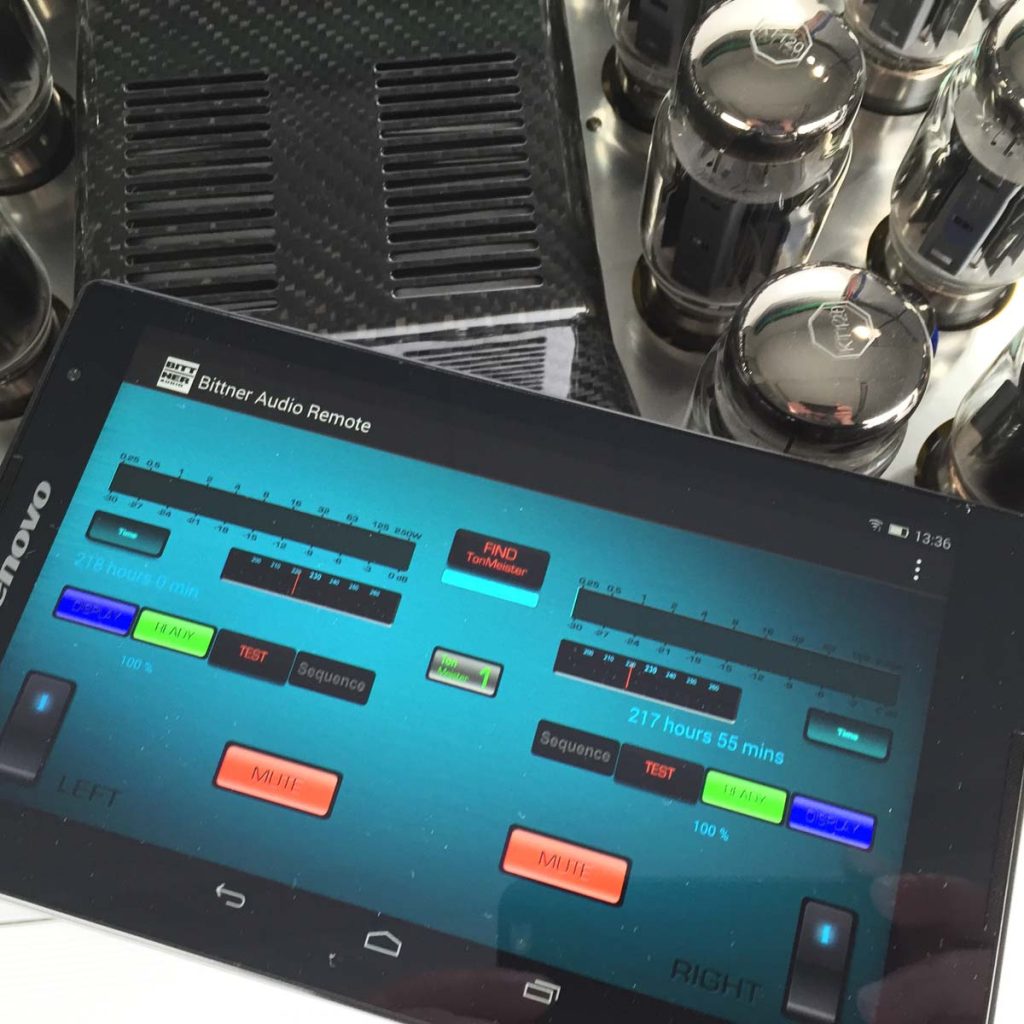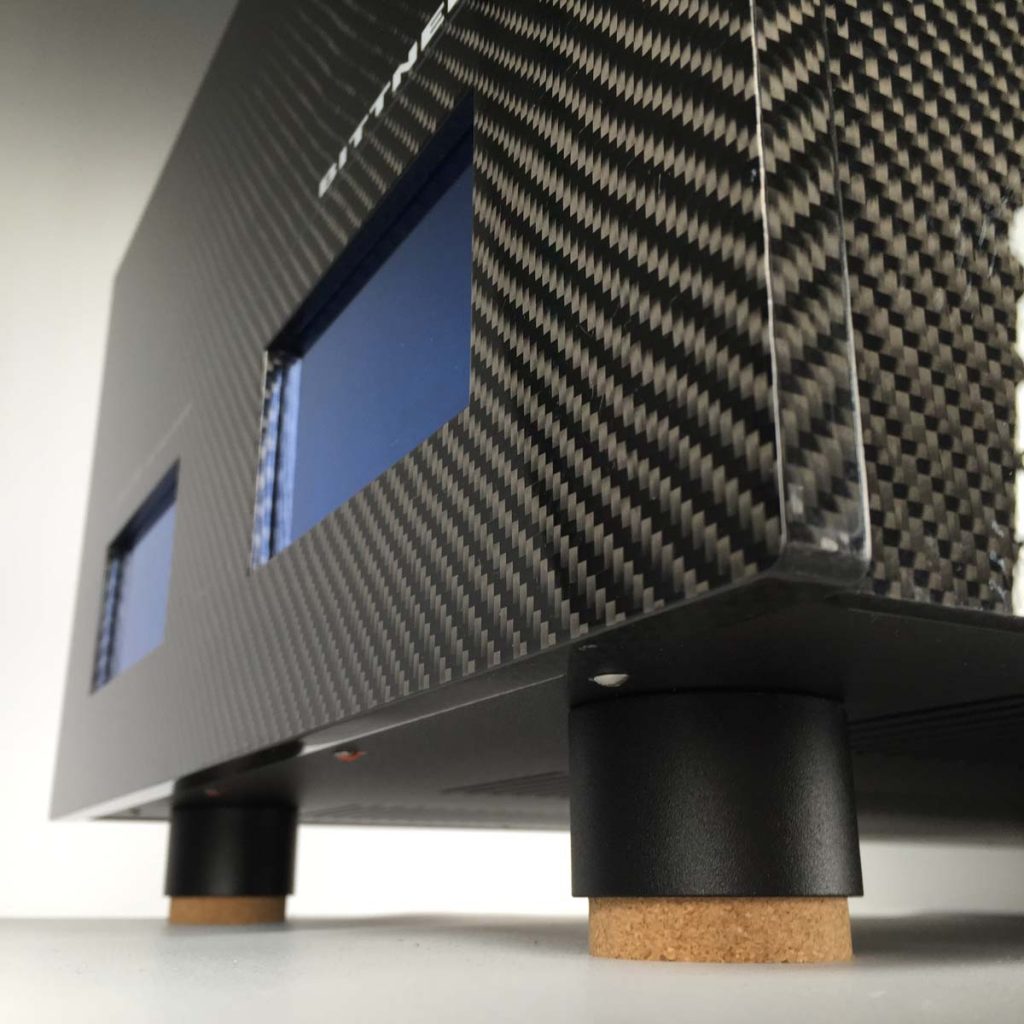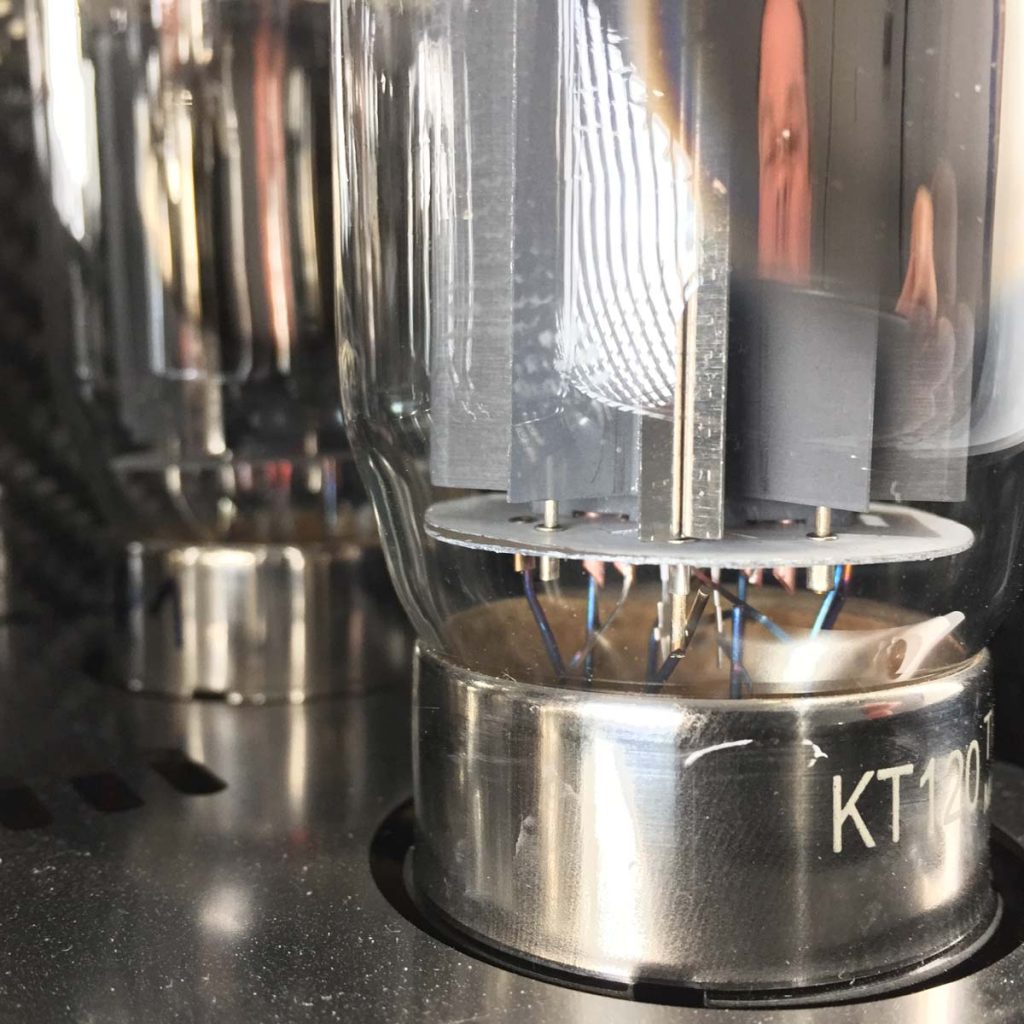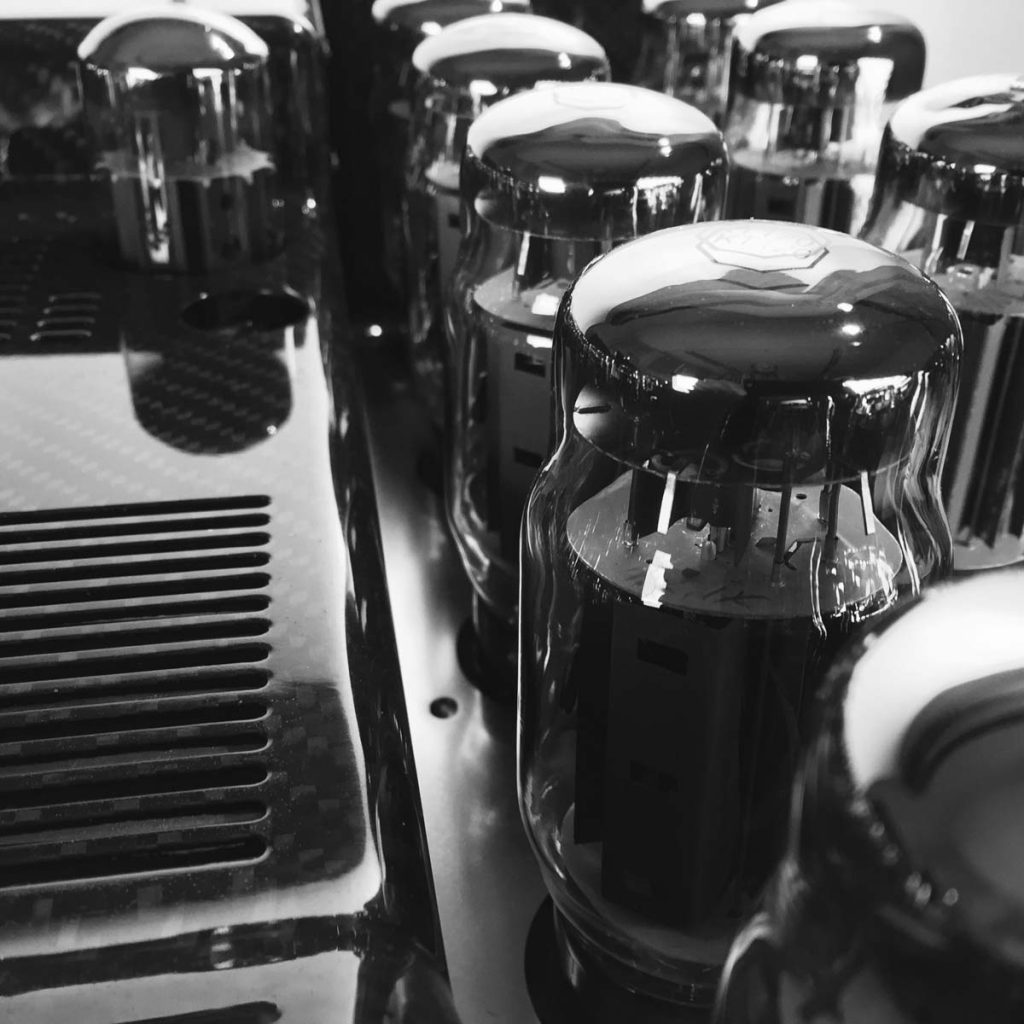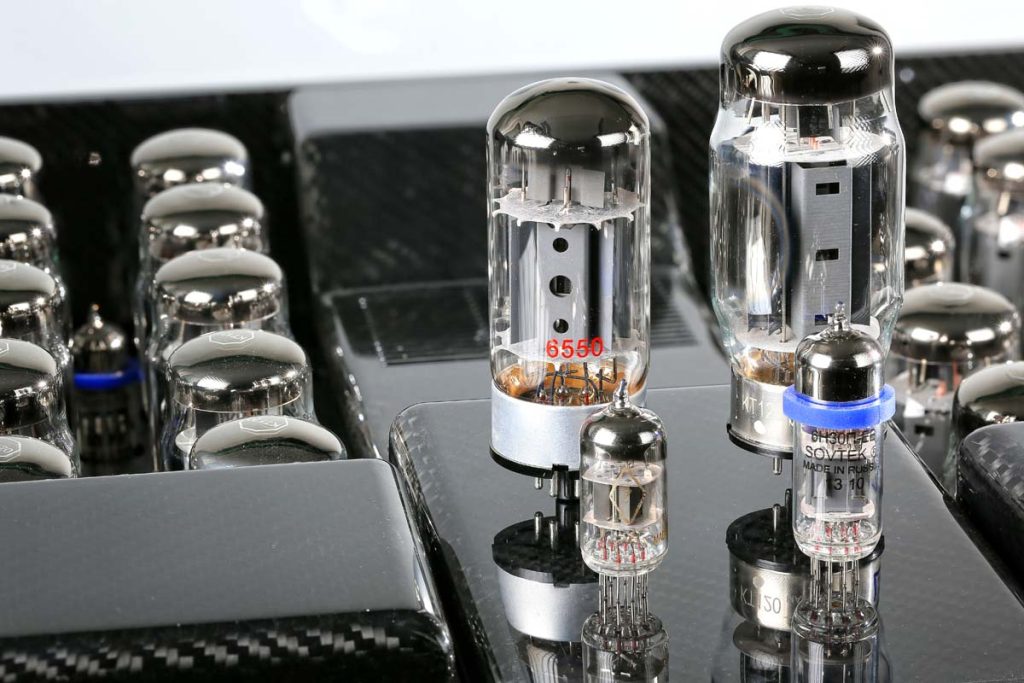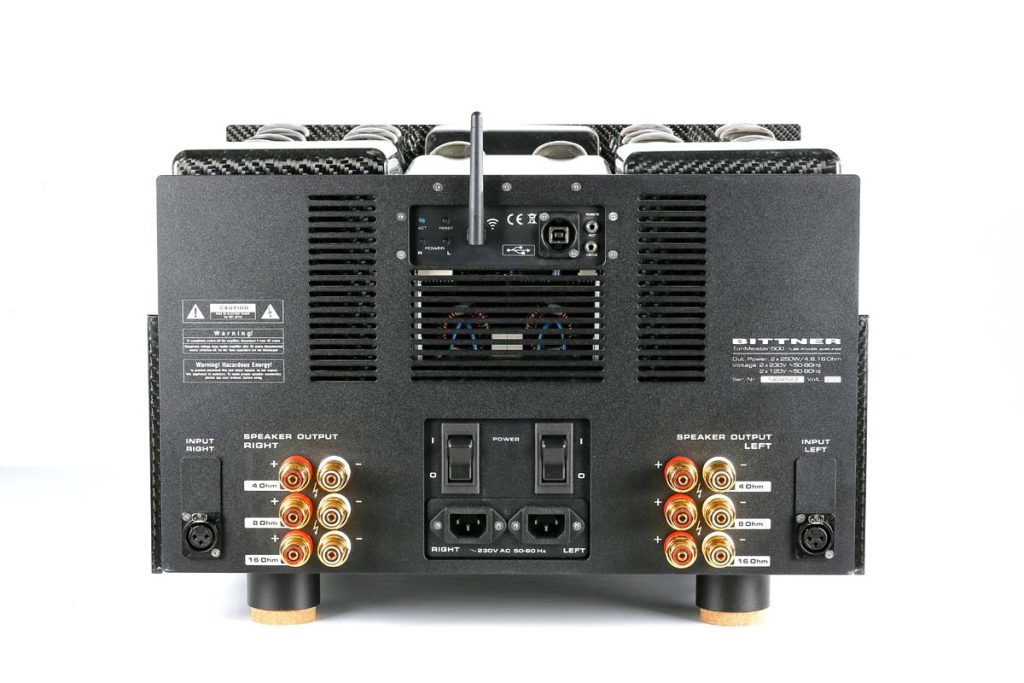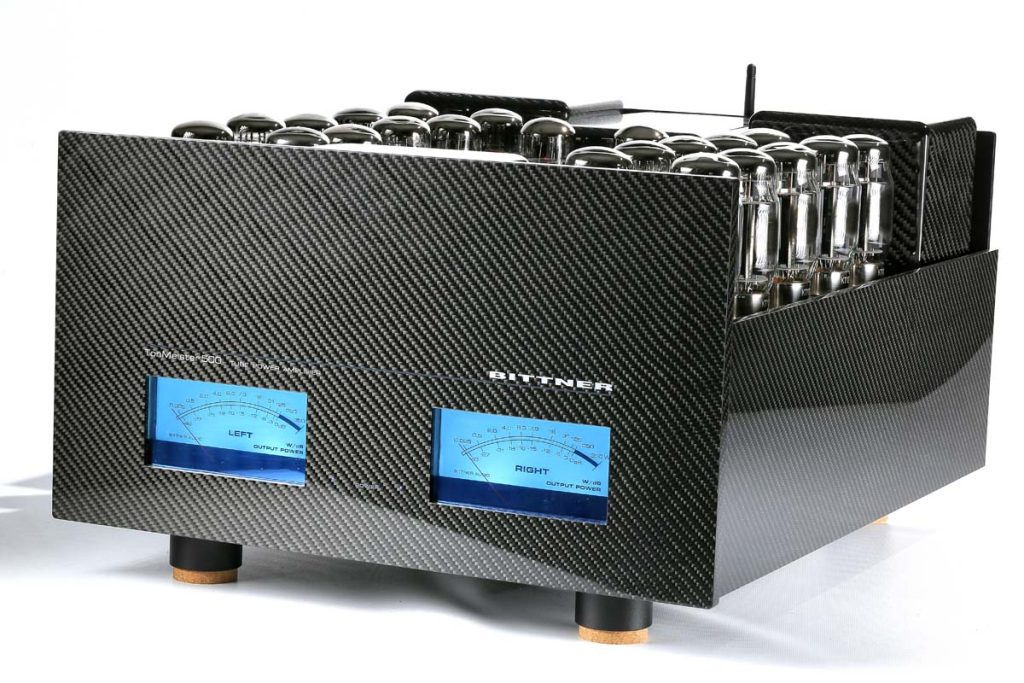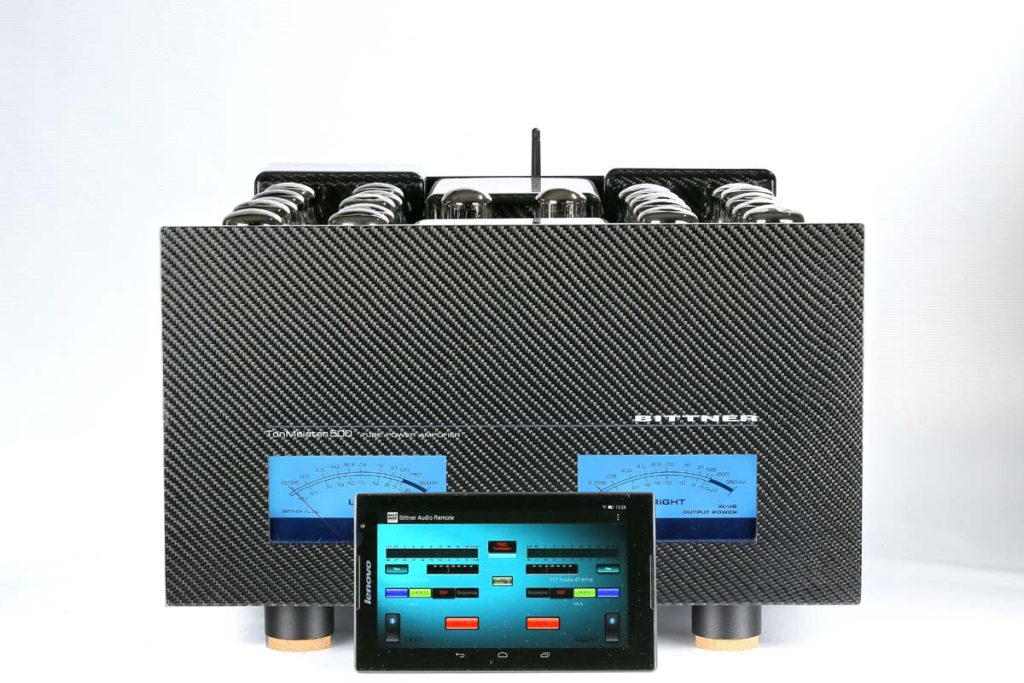Professional Power for Connoisseurs
Let’s Start by Laying it all out for You: Twenty-Six Tubes, 250 Watts Twice, Dual-Mono-Design, Two Power Cords, Switching-Mode Power Supply Units, a Tablet Computer, Wi-Fi and a whole Lot more … this TonMeister is a Master of Sound Engineering and Packs a wide Range of Goodies into a Casing that Looks Like it’s Built for Speed.
If I were a film director, I’d cast this guy for a movie without any audition at all. And I’d probably ask the writers to give him a role where he got to show his stuff as a singer as well. I’d do this because the Bittner TonMeister 500 exhibits an astounding range of talents. First off, it’s almost as large as your neighbor’s garden shed, containing more than two dozen tubes. This alone is enough to attract anybody’s attention. Once you get up close though, there’s a whole lot more to captivate the eye and the ear. You’ll probably first notice the array of glass tubes on the top and the large wattmeters on the front panel. But don’t forget the sleek carbon gloss finish. And the two power sockets. And the small antenna. And the slim tablet computer for remote control. Once you’ve noted all this, we can proceed. Let’s hook up with the guys we’ll be playing with. They need to be really good, of course, because the TonMeister 500 expects others to demonstrate a similar high level of quality.
At first glance, our muscular master of sound engineering may appear a little domineering. But once you get to know him, you’ll find he’s friendly, obedient and absolutely disciplined — a professional sound engineer with no allures. This is because Bittner Audio has been making high-quality professional sound equipment for a decades now. The company has 50 employees and is headquartered in Franconia and Slovakia. Both avid hi-fi fans, Bittner’s chief engineer, Jozef Viskupic, and Managing Director Joachim Schwarz have long dreamed of creating a new type of amplifier for the high-end audio scene — one that’s capable of satisfying a wide range of requirements and possessing the boldness to tackle any task demanded of it. The first fruit of these efforts is this 65-kilogram colossus whose dimensions present a real challenge to hi-fi furniture. It’s no problem for our favorite racks though: Subbase Shambala, Quadraspire X-Reference and Solidsteel HS are well able to cope with the TonMeister 500 — but in a somewhat unorthodox way. With 19-inch studio proportions, the amplifier is a massive 65 centimeters deep and only fits sideways onto our high-end furniture. Anyone thinking of purchasing a suitable rack for this unit will need to look at XXL versions.
Once you’ve dealt with the special space requirements — not forgetting to allow for a little extra room for our warm friend to breathe — the TonMeister becomes your humble servant. The only small luxury it demands is a little time to warm up:
Once you’ve switched the TonMeister on, it takes around three minutes before you can enjoy the first notes. While we’re on the subject of starting up the device — it’s not enough to activate the two large switches on the back: These only turn on the TonMeister’s stand-by mode and a Wi-Fi module — an unusual component for a high-end amplifier perhaps, but a feature often found in professional sound equipment. Although the little black antenna on the unit is a subtle indication of the use of Wi-Fi, the tablet computer that comes with the TonMeister package is the real giveaway. Once the amplifier has been incorporated into a network using the preinstalled app, the owner can control and monitor the amp (or amps, there are actually two of them) using the tablet.
Actual power-up takes place using the tablet or by activating a tiny button on the back of the unit. This triggers the soft-start countdown that validates and stabilizes all important components and circuitry over the course of the next three minutes. You will eventually hear two soft clicks to indicate that the individual channels are usable. Just a quick click on the mute buttons and we can start. The tablet can also monitor various aspects of the TonMeister (see the separate box to read about the technical details) and even control the backlights on the individual wattmeters.
There are some who won’t find anything positive about this lengthy start-up procedure, an amazingly complex process for a power amp. It’s certainly entertaining, but a simple old-fashioned on/off switch on the front would have probably sufficed. Or maybe two switches, this being a dual-mono device. Whatever your preference, this three-minute info show already tells us something important about the device: This robust, superbly crafted and stalwart power amp eats out of the owner’s hand. Sharing an especially torsion-resistant aluminum chassis, the two monoblocks are surrounded by a sleek, eye-catching carbon shell. But carbon isn’t being used to make the TonMeister 500 a lightweight racer. There are no deep-seated sound-related explanations either. The simple reason for choosing this high-tech material was, in the words of Schwarz, “because Bittner Audio can.” This justification alone will gain the amplifier a place in the hearts of many high-end fans, and they might even order a matching set of Furutech power cables with carbon-finish connectors. By the way, these cables really are an excellent accessory for the TonMeister 500, and not only from a visual perspective. According to Viskupic, the power cables supplied with the amp are “really only meant for checking that everything is working.” The company doesn’t want to force anything on its high-end fans.
And this Bittner device clearly indicates whether an accessory such as a power cable is suitable or not: Any change in the position of the cable or the connected equipment is registered immediately. This is, of course, something one expects from a device with such high standards and price. What really amazes me though is how it’s able to hide the fact that it’s a tube amplifier. Even on standard “transistor amp” terrain, the TonMeister is more than a match, and there’s absolutely no interference to be heard from the tubes. And there’s also no trace of compromise in the dynamism and performance it provides — well, perhaps there’s a hint of tubular suppleness. If I were listening to this crisp, controlled sound with a blindfold on, I’m not certain I’d be able to tell it was emanating from a tube amplifier. And that’s exactly what its developers were aimed to achieve. Viskupic even talks about the tube array as “part of the show.” This attitude may not go down well with hardcore tube fans of the Belcanto and Euphonie variety. But for proponents of a neutral sound ideal, this clear commitment to not having a specific sound will be welcomed with open arms.
The TonMeister doesn’t seem to care what speakers you attach to its massive screw terminals for sixteen, eight and four ohms. The device always remains in effortless and unobtrusive control. The dual-mono powerhouse conducts with enormous authority and agility, even with bass notes that can be problematic for tube amps. Such excellent control should never be taken for granted, even with devices of this caliber, however once you learn that Bittner Audio uses the capricious Dynaudio Consequence and a pair of Bowers & Wilkins 800 Nautilus to fine-tune its output (among other equipment), this superb authority is readily explainable. A tube amplifier at ease with loudspeakers of this stature has absolutely nothing to be afraid of.
Nevertheless, I’m not sure I quite agree with those players of electric guitar or electric bass who claim the performance specifications of tube amps need to be tripled when compared with transistor amps (“one tube watt equals three transistor watts”) or even multiplied by eight! During the lengthy tests of the TonMeister, I was only once able to overextend it. But that was completely intentional, caused by playing an appalling dub track and fully expecting complaints from my neighbors.
Generally speaking, I find it reassuring to know I can hook up even the most demanding of speakers despite the fact that most musical enjoyment (in my case at least) takes place at levels that barely register on the wattmeters on the front of the unit. With this in mind, I would welcome a somewhat finer or configurable calibration on these wattmeters: If you have a needle, you actually want to see it jumping around. You can see a lot more happening on the tablet’s screen due to the display form that features a bar graph. Admittedly, however, viewing all this action can distract the observer from what the amplifier is actually supposed to be doing. After all, I want to listen to music and not stare at a screen. (Or end up switching off a channel by mistake because of chubby fingers…)
So I decide to put the tablet away and focus on the music. But that’s not as easy as it sounds. This is because the TonMeister is such a master of “high-fidelity” that I am quietly but emphatically immersed in the respective sound scenario. This illusion of actually being in the middle of a live performance is a fascinating high-end impression that only truly great audio systems in a suitable environment are capable of creating alone or in combination with other high-end devices. The superb Bittner Audio TonMeister 500 is definitely such a system, a heavyweight champion not only in terms of its kilos! It certainly deserves the role of the strapping, self-assured action hero with a heart and soul to match.
The Technology
Inside The Bittner Tonmeister 500
Head developer Viskupic put all his 25 years’ experience of engineering and manufacturing professional power amps into the design of Bittner Audio’s first high-end model. The Bittner Audio TonMeister 500 features two monoblocks mounted on a single chassis, bringing an additional improvement in crosstalk attenuation, especially for bass tones. This means any voltage fluctuations in one channel cannot have a detrimental effect on the other’s sound. Hand-crafted, high-precision transformers and 10 carefully selected and matched KT 120 power tubes ensure absolutely identical values on both channels. Word has it that only 10 percent of the tubes pass the stringent tests ensuring the rigid standards regulating this “zero-tolerance tube technology. The two 6H30 tubes — those with the blue damping rings located between the four foremost power tubes — are responsible for ensuring an adequate symmetry of performance. These are powerful double triodes of Russian manufacture. This outstandingly well-equipped tube amp has two separate high-performance switched-mode power supplies, one for each monoblock, that provide more than 4,000 watts. These switched-mode power supply units contain filter stages that prevent even the tiniest interference level from reaching the highly sensitive tube grids. Much of the input power, a full 40 amps at 6.3 volts, is required to warm up the output tubes. Two analog wattmeters on the front of the device itself indicate the output power level. This can reach up to 250 watts per channel, with a distortion of less than 0.5 percent — a tremendous figure for a tube amplifier. The head developer ascribes this to the previously described zero-tolerance tube technology. Over and above this, the designer wasn’t prepared to reveal more technical details. (Which I think is a pity — the insides of this amp are pretty spectacular and definitely don’t deserve to be shrouded in secrecy.) What the hi-fi devotee can do, however, is keep a watchful remote eye on each tube: After connecting up the tablet computer — delivered with the device — to the amp, you can monitor the power output in watts or decibels, the voltage supply per channel, and (in test mode) even the bias voltage to individual tubes. The tablet can also be used to activate, deactivate, or mute each channel and even to individually control the backlighting on the wattmeters at the front of the unit (on, off, or dimmed). Rounding out the exceptional functionality of this Bittner device are displayable counters (one for each channel, of course) showing the number of operating hours. P.S.: Bittner Audio will soon be presenting a suitable sidekick for the TonMeister 500 — a high-level preamp with an external power supply. This will be unveiled at HIGH END 2016 in Munich. There are also concrete plans for expanding the product family with “true” monoblocks in tower chassis (boasting twice the performance of the 500!) and a suitable phono preamp.
Erich Engel
Accompanying Equipment
Digital sources: AcousticPlan Vadi, Audio Note CDT 3/DAC 3 Signature, C.E.C. TL 0 3.0/DA3N, T+A PDP 3000 HV | Turntables: Clearaudio Innovation/TT-II/DaVinci, EnVogue Astra/Nottingham Analogue Anna 12”/EMT JSD 75S | Phono equalizers: Clearaudio Absolute Phono, Synthesis Roma 79DC | Preamplifiers: Bryston BHA-1, Einstein The Preamp, Nagra Jazz, Valvet Soulshine | Loudspeakers: Bowers & Wilkins 803 D3, KEF LS50, Live Act Audio LAS 312, Stereofone Dura | Cables: Audio Note, AudioQuest, Furutech, HMS, Vovox | Power supplies: IsoTek Aquarius EVO3, T+A Power Bar 2+3 | Accessories: LignoLab Die Bank and TT100, Quadraspire X-Reference, Solidsteel HS, various products from Steinmusic and Subbase Audio
Tube power amplifier
Bittner Audio TonMeister 500
Power output (16/8/4 O): 2 x 250 W | Inputs: 1 x balanced (XLR), optionally also unbalanced (cinch) | Outputs: one pair of speakers (screw-type terminals) | Tubes: 20 x KT120, 2 x 6550, 2 x 6N30, 2 x 6N1P | Special features: strict dual-mono design, soft start, tablet computer with Bittner app and Wi-Fi module as part of package, removable tube protection grille with temperature-controlled fans | Casing: front, sides and cladding are carbon; chassis and rear are aluminum | Dimensions (W/H/D): 48.3/30/65 cm | Weight: 65 kg | Warranty period: three years | Price: €49,000
Bittner Audio International GmbH
Forststr. 21a
95488 Eckersdorf
Germany
Phone: +49 921 50703680

